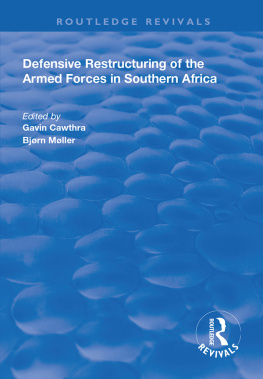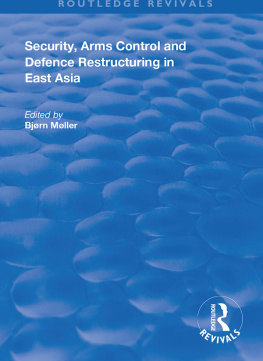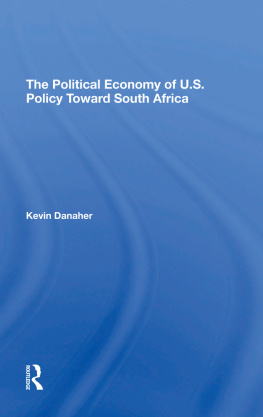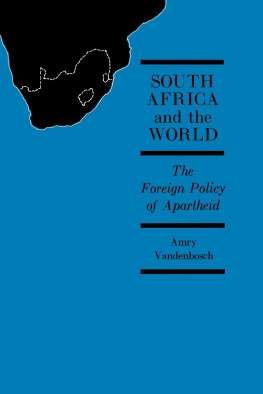First published 1997 by Ashgate Publishing
Reissued 2018 by Routledge
2 Park Square, Milton Park, Abingdon, Oxon, OX14 4RN
711 Third Avenue, New York, NY I 0017, USA
Routledge is an imprint of the Taylor & Francis Group, an informa business
Copyright Gavin Cawthra, Bjrn Mller 1997
All rights reserved. No part of this book may be reprinted or reproduced or utilised in any form or by any electronic, mechanical, or other means, now known or hereafter invented, including photocopying and recording, or in any information storage or retrieval system, without permission in writing from the publishers.
Notice:
Product or corporate names may be trademarks or registered trademarks, and are used only for identification and explanation without intent to infringe.
Publishers Note
The publisher has gone to great lengths to ensure the quality of this reprint but points out that some imperfections in the original copies may be apparent.
Disclaimer
The publisher has made every effort to trace copyright holders and welcomes correspondence from those they have been unable to contact.
A Library of Congress record exists under LC control number: 97002977
ISBN 13: 978-1-138-61413-0 (hbk)
ISBN 13: 978-0-429-46380-8 (ebk)
BJRN MLLER AND GAVIN CAWTHRA
Most of the contributions to the present work were originally written for a conference on Defensive Restructuring of the Armed Forces in Southern Africa. It was held at Helderfontein near Johannesburg in March 1996, organised by the Global Non-Offensive Defence Network and the Defence Management Programme at the Graduate School of Public and Development Management, University of the Witwatersrand, Johannesburg. The conference was attended by military officers, defence officials and academics from throughout Southern Africa as well as international experts. This was the first time that the issue had been discussed openly and on a multilateral basis in Southern Africa.
For financial support for this conference the editors wish to thank the Ford Foundation and the Danish Ministry of Foreign Affairs. For their practical and technical assistance in the conference as well as with the production of the present work they are also indebted to Mrs. Janne Rotberg, Ms. Rikke Strange and Ms. Cennet nver. Above all, however, they are grateful to Mrs. Helle Christiansen Cawthra who has been a tremendous help through all stages of the project.
Johannesburg and Copenhagen
December 1996
Bjrn Mller and Gavin Cawthra
BJRN MLLER
This chapter is intended as an introduction to the concept of non-offensive defence (NOD): its underlying philosophy and the basic design principles. Some attention is given to the amendments of the original NOD conceptions that will be required to make them applicable to a Third World setting. The chapter further provides a short historical account of the global debate on defence restructuring followed by an assessment of the present state of this debate. By arguing the relevance of NOD to regions such as the Middle East and East Asia the chapter thus places the South(ern) African debate in perspective. Before proceeding any further it does, however, seem advisable to clear away some conceptual confusion often encountered.
As a concept, NOD refers to a strategy, materialised in a military posture which possesses sufficient defensive strength while lacking offensive capabilities (vide infra).
There are several terms for this concept. As a term, NOD thus has many synonyms such as defensive defence, non-provocative defence, nonaggressive defence, confidence-building defence or structural inability to attack. While referring to the same concept, the various terms highlight different aspects thereof (just as the proverbial blind men describing the same elephant, one focusing on its legs, another on the trunk, etc.).
There are numerous alternative design principles, i.e. models, such as territorial defence, barrier-type defence, disengagement, etc. (vide infra). Even though each model designer (including those represented in the present volume) has his favourite term, this does not mean that these preferred terms refer to particular models. They all refer to the same concept, on the best realisation of which opinions differ.
What is NOD?
While a few authors have recommended non-offensive defence (NOD) for reasons of sheer military efficiency, the reasoning of most NOD advocates is political. They argue that it will serve the national interests of states to pursue policies of common security, and that the international system as a whole will become more stable and peaceful if all states do so.
If one state, for instance, builds up its military power to correct a perceived deterioration in the balance of power, this will be perceived (correctly, regardless of intentions) by its adversaries as a growing threat. Hence the latter will be inclined to reciprocate with a rearmament that will only make the former state feel even more insecure. The result may well be a spiralling arms race.
In a political crisis mobilisation and other defensive measures may be mistaken for attack preparations, which will give a states adversaries incentives for preventive war and/or pre-emptive attack, implying a considerable crisis instability.
In its more parsimonious interpretations, the principle of common security entails little more that an acknowledgement that the security of an adversarial dyad has to be viewed as a whole, i.e. that neither side can achieve lasting security at the expense of its respective adversary. The post-Cold War version of this philosophy is better known as cooperative security, an approach endorsed (with some delay) by European organisations such as the OSCE and NATO, and which also plays an important role of security political reorientation in Southern Africa (see, the chapter by Gavin Cawthra as well as the appendix). Cooperative security is largely synonymous with common security, only with a slightly greater emphasis on intentional and institutionalised cooperation.
The simple maxim of common security should, of course, also be applied to defence policies where it immediately translates into the concept of NOD: the acknowledgement that security against military attack is not achievable by means of offensive threats which will only be reciprocated, leaving both sides in a worse situation. NOD might best be defined in functional and relative terms that allow for viewing it by degrees, i.e. to conceive of NODdiness as a continuum: NOD is a strategy, materialised in a national posture that emphasises defensive at the expense of offensive military options
A shift to NOD will both improve arms race and crisis stability. First of all, inadvertent arms races may be averted: if the weapons deployed only enhance defensive strength without posing threats, one states build-up of arms will call for no reciprocal steps on the part of its adversaries. States with aggressive intentions may, of course, want to respond to the strengthening of defensive capability by others with a commensurate build-up of their offensive strength, but by doing so they will reveal their intentions. This revelation will, in itself, improve the security of their adversaries who will know for what to prepare. Above all, however, dyads of genuinely defensively oriented states may escape the vicious circle of mutually reinforcing and legitimating arms acquisitions and, hopefully, proceed to actual disarmament.







